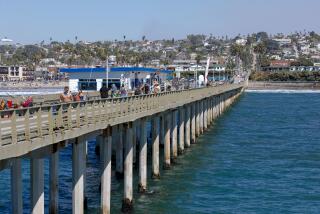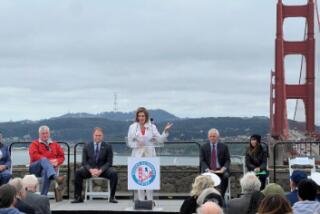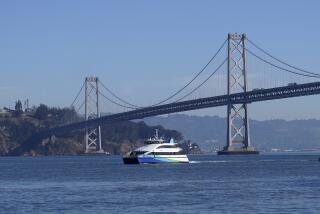Golden Gate barrier studied
SAN FRANCISCO — Officials here took another step Tuesday toward approving a suicide prevention barrier for the Golden Gate Bridge, the 71-year-old span that has long been at the center of a controversy pitting safety against aesthetics.
Bridge officials released an environmental impact report that explores the cost and feasibility of five design options that include raising the existing pedestrian rail from 4 feet to 12 feet and installing nets that would catch jumpers.
Mary Currie, a spokeswoman for the Golden Gate Bridge, Highway and Transportation District, called the report “a milestone.” “We have never done a formal environmental analysis before,” she said. “This is the furthest we’ve seen any suicide barrier discussion go.”
But Currie said the agency has no money to fund any version of the barrier project, which would cost $25 million to $50 million.
Since the bridge opened in 1937, an estimated 2,000 people have jumped from it. The deck is about 260 feet above the water. After falling about four seconds, jumpers hit the water at about 88 mph. The impact is nearly always fatal, and most who survive it die in the frigid water.
An average of 20 people jump to their deaths each year, but 35 died in 2007.
Barrier proponents reacted to the study with both frustration and optimism.
“How many more people will die, how many more families have to grieve before these people finally do something?” asked David Hull, president of the pro-barrier Bridge Rail Foundation, whose 26-year-old daughter committed suicide on the bridge in 2003. “They’ve been talking about this barrier for the last 70 years. . . . How long can the talking and the mulling go on?”
Currie said one challenge has been that the Art Deco suspension bridge, which connects San Francisco with Marin County, is eligible for inclusion on the National Register of Historic Places, which would add hurdles to altering the structure. Eve Meyer, executive director of San Francisco Suicide Prevention, said she hoped that some type of suicide barrier would be completed one day soon along the 1.7-mile span.
“There are a lot of myths and superstitions about suicide that have helped kill the 2,000 people who have died on this bridge,” she said. “There’s the feeling that they’re going to kill themselves anyway, so why ruin an otherwise beautiful bridge? Others believe the suicidal deserve what they get.”
Currie said the public has 45 days to weigh in on whether to install a suicide barrier. Along with two public meetings in San Francisco and Marin County, comments can be made on the agency’s website: www.ggbsuicidebarrier.org.
She said a barrier decision could come as early as October.
--
More to Read
Sign up for Essential California
The most important California stories and recommendations in your inbox every morning.
You may occasionally receive promotional content from the Los Angeles Times.











